Is This the Isthmus? Tour – Mexico Part 22
Thursday, October 19, 2017
Mexico City, Mexico

Looking toward the Torre Latinoamericana skyscraper in Mexico City, Mexico.
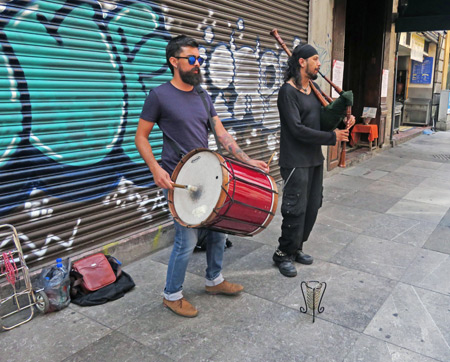
Street musicians in Mexico City, Mexico.
Today, I tried to visit the Museo Diego Rivera, but, except for one main mural, the place was closed. (It seemed like every museum in Mexico City was either closed completely or had a bunch of whole sections roped off.) Instead of paying just to see one piece, I walked a few blocks over to the Museo de Arte Popular. That turned out to be a wise choice, as the place is utterly jam-packed with all kinds of awesome “low-brow” art from all over Mexico. Just for starters near the entrance, there was a Volkswagen Beetle and guitars covered with psychedelic beads. The floors upstairs were chock-full of devil masks, models of bullfight arenas, Dia de Muertos skeleton displays, fanciful paper maché creatures, and way more.

A Volkswagen Beetle covered with psychedelic beads at the Museo de Arte Popular in Mexico City, Mexico.
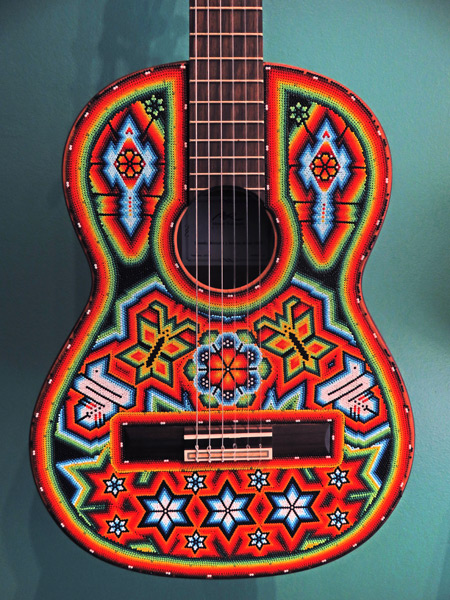
Dos Mariposas en Vuelo (an acoustic guitar covered with psychedelic beads) by Anselmo Hernandez Robles at the Museo de Arte Popular in Mexico City, Mexico.
“The Museo de Arte Popular is a museum in Mexico City, Mexico that promotes and preserves Mexican handcrafts and folk art. Located in an old fire house in the historic center of Mexico City, the museum has a collection which includes textiles, pottery, glass, piñatas, alebrijes, furniture and much more. However, the museum is best known as the sponsor of the yearly Noche de Alebrijes parade in which fantastical creatures are constructed on a monumental scale and then paraded from the Zocalo to the Angel of Independence monument, competing for prizes.

Jaguar and tiger masks at the Museo de Arte Popular in Mexico City, Mexico.
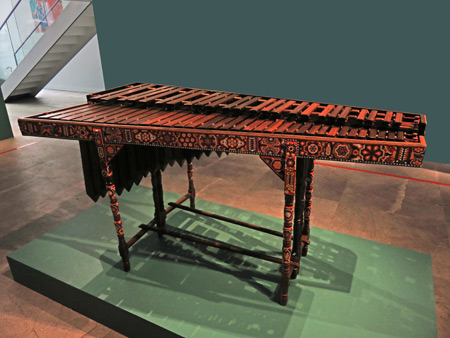
A marimba covered with psychedelic beads at the Museo de Arte Popular in Mexico City, Mexico.
“Opened in March 2006, the museum’s permanent collection contains both older and newer craft pieces from the various traditions that make up Mexican culture. The collection was gathered through the generosity of individual donors. Some of the principal private donors include Alfonso Romo of Grupo Savia, who had promoted crafts for a number of years. He donated 1,400 pieces toward the opening of the museum. The second donor was Carlota Mapeli, who came to Mexico from Italy in the 1970s and dedicated herself to collecting embroidered garments and other textiles. She donated 400 pieces, many of which were weaved on backstrap looms.
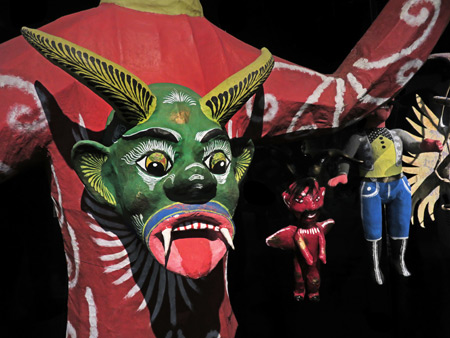
Judas (foreground) by Miguel Linares at the Museo de Arte Popular in Mexico City, Mexico.

El Hermano Venado (an electric guitar covered with psychedelic beads) by Anselmo Hernandez at the Museo de Arte Popular in Mexico City, Mexico.
“The collection is organized into five permanent halls divided by theme, and two dedicated to ‘grand masters,’ each of which contains various kinds of crafts. The five themed halls are called “Las Raices del Arte Nexicano” (Roots of Mexican Art), “Las Raices del Arte Popular” (Roots of Crafts or Popular Art), “Lo Cotidiano” (Everyday Things), “Lo Religioso” (Religious Items) and “Lo Fantasmagico” (Fantastic and Magical Things). The collection fills three of the four levels of the building, for a total of 7,000 square meters. There is also a temporary exhibit hall and an “interpretation” room, which has pieces from all 32 of the federal states of Mexico, as well as the Distrito Federal. Crafts displayed here are of many different types, including pottery, basketry, wood carving, precious metal working, glasswork, textiles, papier-mâché and others. The museum also has a research center with a library and a periodical archive.”–Wikipedia

Purgatory Mask by Zenaida Rafael Julian at the Museo de Arte Popular in Mexico City, Mexico.

The serene pathways of Alameda Park in Mexico City, Mexico.
Next, I took an enjoyable stroll through the extremely pleasant Alameda Central park. This place is criss-crossed with wide, smooth walkways perfect for walking, skateboarding and fruit booting–the latter two of which are illegal, but plenty of people do it anyway! My third and final stop of the day was Palacio de Bellas Artes, a cultural center that is filled with huge murals from the likes of Diego Rivera, Jorge Gonzalez Camarena, David Alfaro Siqueiros, and others. Some of them are quite explicit, containing no small share of nudity and violence.
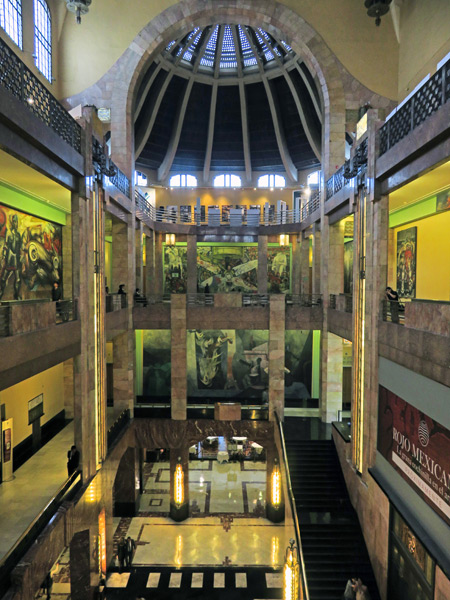
The interior of the Palacio de Bellas Artes in Mexico City, Mexico.

Catharsis a la Eterna Lucha de la Humanidad by Jose Clemente Orozco at the Palacio de Bellas Artes in Mexico City, Mexico.
“The Palacio de Bellas Artes (Palace of Fine Arts) is a prominent cultural center in Mexico City. It has hosted some of the most notable events in music, dance, theatre, opera and literature, and has held important exhibitions of painting, sculpture and photography. Consequently, the venue has been called the “Cathedral of Art in Mexico.” The building is located on the western side of the historic center of Mexico City next to the Alameda Central park. The first National Theater of Mexico was built in the late 19th century, but it was soon decided to tear this down in favor of a more opulent building in time for Centennial of the Mexican War of Independence in 1910.
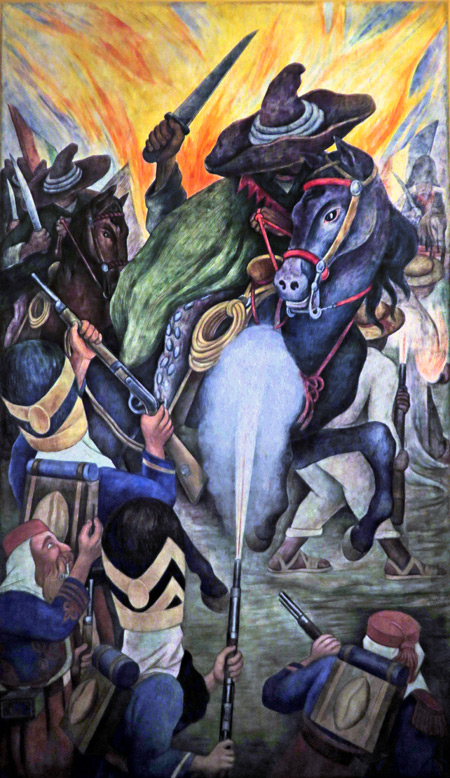
Agustin Lorenzo (Danza de Huejotzingo) by Diego Rivera at the Palacio de Bellas Artes in Mexico City, Mexico.
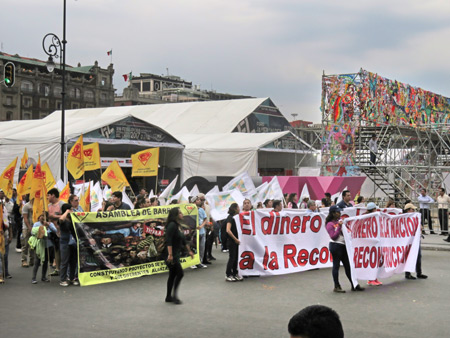
A political rally at the Zocalo in Mexico City, Mexico.
“The initial design and construction was undertaken by Italian architect Adamo Boari in 1904, but complications arising from the soft subsoil and the political problem both before and during the Mexican Revolution, hindered then stopped construction completely by 1913. Construction began again in 1932 under Mexican architect Federico Mariscal and was completed in 1934. The exterior of the building was primarily designed in a Neoclassical and Art Nouveau style, while the interior is primarily Art Deco. The building is best known for its murals by Diego Rivera, Jorge Gonzalez Camarena, David Alfaro Siqueiros and others, as well as the many exhibitions and theatrical performances it hosts, including the Ballet Folklórico de México.”–Wikipedia
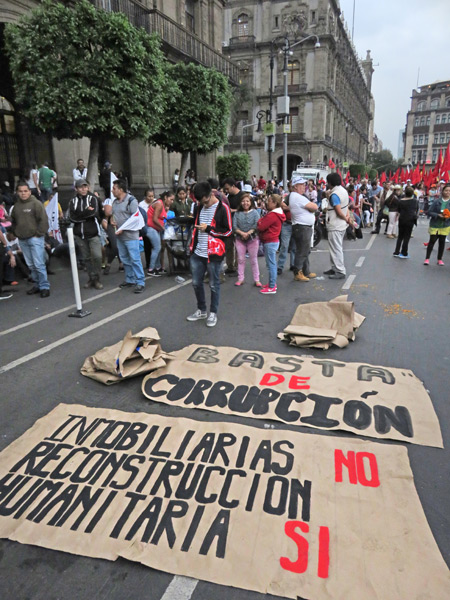
A political rally at the Zocalo in Mexico City, Mexico.

A political rally at the Zocalo in Mexico City, Mexico.
Just before I left, I decided to shoot a photo of one more mural, when a silly security guard told me to stop. He said photos were allowed to be taken with a smart phone, but not a camera. I’ll bet the original rule was written to ban professional camera gear with a tripod, and this guy just applies it to any camera—even small point-and-shoots like mine. How petty! When I exited the subway at the Zocalo, there was some kind of protest rally / parade going on. Judging from the banners, I think it had something to do with the Mexican government not giving people enough money to rebuild after the recent earthquakes.
Words and photos ©2017 Arcane Candy.
Leave a Reply